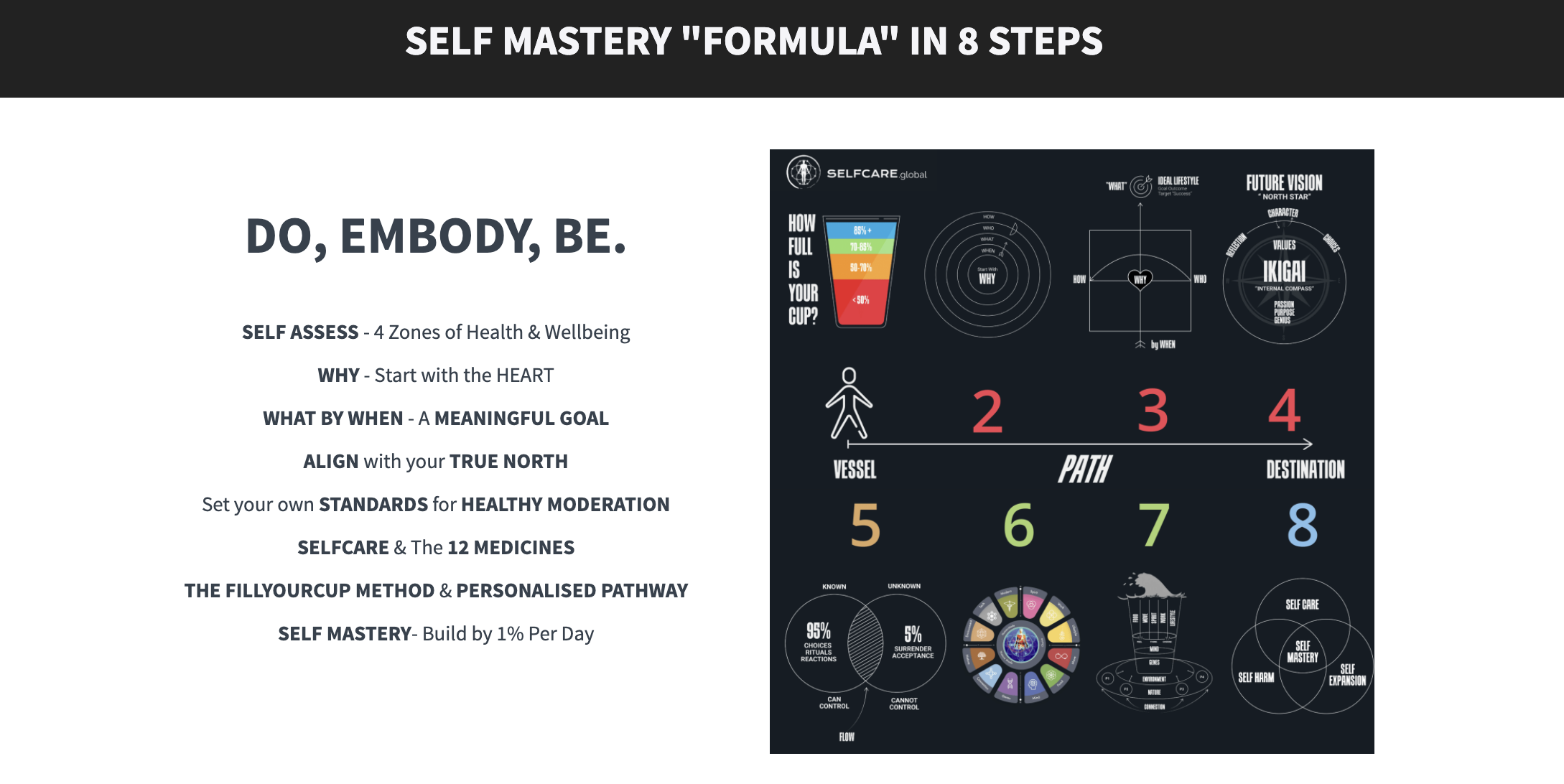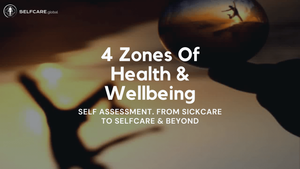EMBRACE DEATH TO FULLY LIVE
This may be an uncomfortable conversation, but it is one that is necessary to have. Many cultures embrace death as a part of life, whereas others are taught to fear it in the hope of finding “anti-ageing elixirs,” the “fountain of youth” and ways of resisting the inevitable. Change is a necessary part of life and life is circular, not linear.
Consider how many minds have been referenced in this book, names that no longer live in their physical form. One could argue that they still live today. It has been said that you die twice, once when you take your last breath and secondly, the last time your name is said.
I hope that embracing death as a part of life, it will inspire people to truly live, taking advantage of the 1,220,000 (~140 years) potential hours we all have access to, spending each breath and minute as if it were the most valuable gift in the world. The unfortunate truth is that many of us limit our human experience to ~613,000 hours (72 years) through the lifestyle we choose to live. What if we changed that? Perhaps the graveyard would no longer be the richest place on the planet; full of all the dreams ideas and innovations that never were.
The Tibetan Book of the Dead shares some insightful perspectives so that we can embrace death as a part of life. Padmasambhava says:
“It is undeniably the case that in our society we do not easily accept that death is a natural part of life, which results in a perpetual sense of insecurity and fear” and asks “are you oblivious to the sufferings of birth, old age, sickness and death? There is no guarantee that you will survive, even past this very day!”
ONE MESSAGE
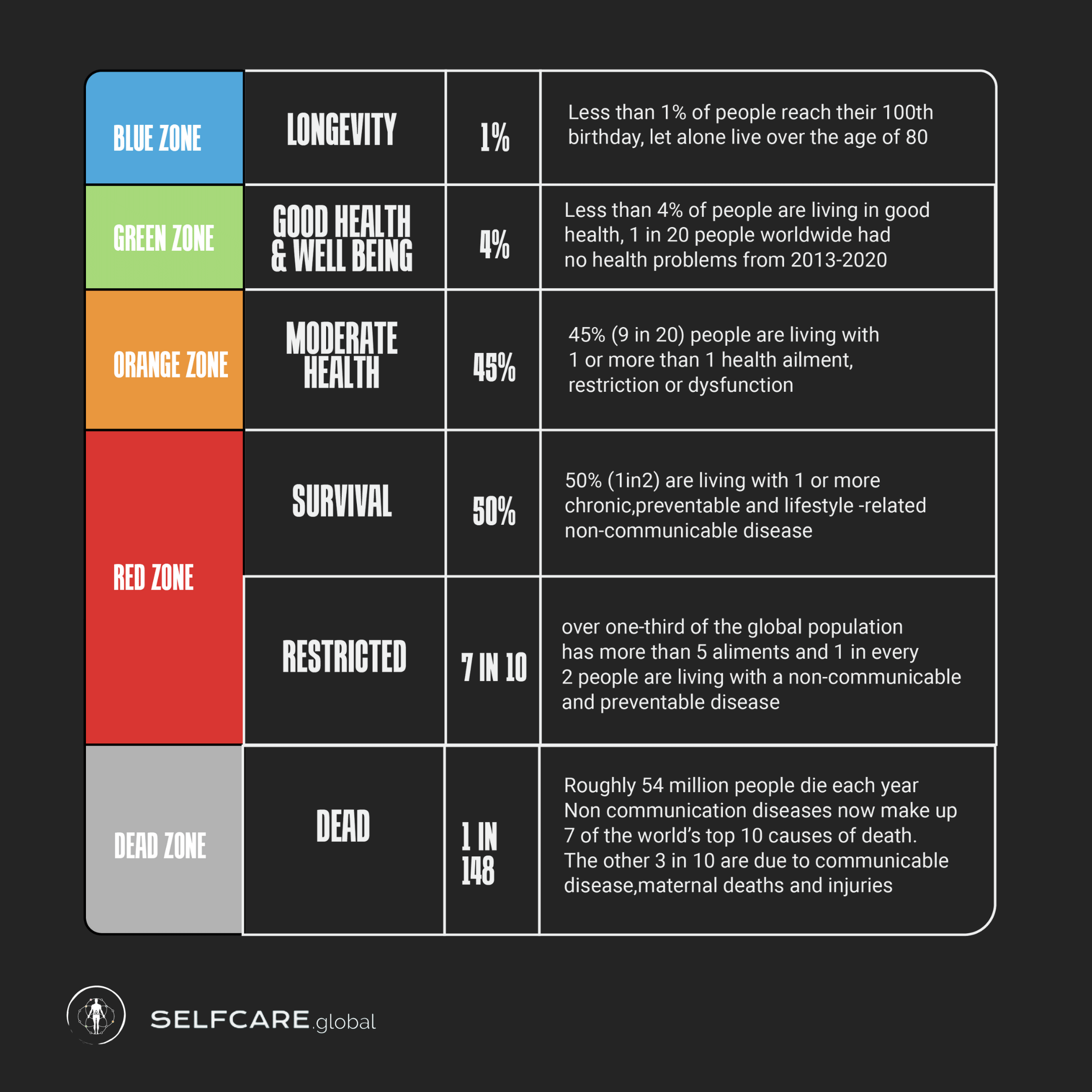
Here’s something you need to know. Think of 100 people you know or love.
- WECARE: Less than 1 in every 100 people live beyond 100 years, let alone over 80 years!
- SELFCARE: 4 in every 100 people (4%) are living in a state of good health and well-being towards longevity.
- HEALTHCARE: 45 in every 100 people are living in the limbo arena of the “orange zone” bouncing between restriction, dysfunction, disease and good health and harmony. Living with 1 or more ailments or health challenges.
- SICKCARE: 50 in every 100 (50%) people are living with one or more chronic or preventable diseases.
It’s not pretty but it’s pretty important. Imagine if we could flip these hard statistics. Where 1 in 2 people were living in good health and wellbeing towards longevity?
Take the Self-Assessment Below
THE DEAD ZONE
(MORTALITY, 50+ MILLION)
To reverse engineer disease and dysfunction, it is important to understand how to live a life free of restriction so that we can live fully. It’s not all bad news either. According to the World Bank, based on 2014 data for every 1,000 people in the world, an average of 7.748 people will die each year and 19.349 will be born.9 That’s a ratio of about 2.5 births for every death. There is more life than death!
In 2019, the top 10 causes of death accounted for 55% of the 55.4 million deaths worldwide.
- Cardiovascular (ischaemic heart disease, stroke)
- Respiratory (chronic obstructive pulmonary disease, lower respiratory infections)
- Neonatal conditions—(birth asphyxia and birth trauma, neonatal sepsis and infections and preterm birth complications).11
If we understand how we die, perhaps we can build a more sustainable and regenerative ecosystem to support each individual over their lifespan. Some people see this population growth as a challenge for humanity. I see it as an opportunity to adapt and evolve the way we live in harmony with the natural world and its resources. As an example, we don’t have a food shortage issue where 1 billion people need to go to bed hungry tonight, 40% is wasted by inefficient systems of distribution and degenerative agriculture. If we have regenerative systems and efficient distribution of resources. We can all survive and thrive together.
Experts break down the burden of disease into three main categories:
- Non-communicable diseases (NCDs);
- More than 60 per cent of the burden of disease results from non-communicable diseases (lifestyle-related).
2. Communicable, maternal, neonatal and nutritional diseases, and
- 28 per cent result from communicable, maternal, neonatal and nutritional diseases
3. Injuries. According to our World in Data reports, on a global scale:
- And just over 10 per cent from injuries.
THE 50% – RED ZONE
(SICKCARE “DIS-EASE AND DIS-ABILITY”)
Do you find it interesting that non-communicable diseases now make up 7 of the world’s top 10 causes of death? According to WHO’s 2019 Global Health estimates
- Non-communicable diseases (NCDs) kill 41 million of the 54 million people each year, equivalent to 71% of all deaths globally.
- Each year, 15 million people die from an NCD between the ages of 30 and 69 years and over 85% of these “premature” deaths occur in low- and middle-income countries.
These are essentially diseases of choice and lifestyle. It would take a courageous person to admit that they chose this state of being without blame and victimization.
Would you be willing to make five small changes in your daily lifestyle choices in order to increase both the length and quality of your life, so that you could spend more quality time with the people that you love? If you did, you would cut your risk of developing a chronic preventable disease by 78%.
You could reduce our risk of dying young by 52%.
Non-communicable diseases are lifestyle-related diseases of affluence and choice (70%).
To move out of the red zone on a PERSONAL level you would need to;
- Learn how to sustain a healthy weight through better daily lifestyle choices
- Address inactivity and make movement a meaningful part of your life
- Address poor food choices and learn how to nourish yourself
- Avoid, stop, swap or quit smoking altogether
- Limit or at least moderate alcohol consumption
If we addressed these five factors, the ambitious target of the Sustainable Development Goal (SDG), to reduce by a third premature non-communicable disease (NCD) mortality by 2030 would become very achievable.
Communicable diseases are linked to birth right, not personal choices (the 20–30%)
When it comes to communicable and infectious diseases, the good news is that there has been a significant reduction in the global burden from communicable diseases in recent decades, falling from over 1.1 billion in 1990 to below 670,000 in 2016 (around a 40 per cent reduction).
Helping more people move out of the red zone will require a team effort. To solve the remaining challenge for the communicable diseases we need to address these 5 factors:
- Prevention and early intervention
- Community education
- Promoting healthy immune systems
- Reproductive and maternal health care
- Creating enabling healthy environments for all children, addressing basic
human needs, like clean water as a starting point!
It’s important to note that non-communicable “lifestyle-related” conditions account for nearly two-thirds of deaths worldwide but communicable diseases are also preventable! This means that most of us can create change in our own lives.
THE 45% – ORANGE ZONE
(HEALTHCARE "DYS-FUNCTION, RESTRICTION")
In the red zone, a focus on mortality (what kills us) does not take into account that the burden of disease not only kills people but also causes deep suffering to people who live with them. People are living longer on average, but they are doing so with more disabilities and restrictions.
Most people in the orange zone think they are living in a state of good health and well-being. Even if their waistline, energy and biomedical measures say otherwise. They often accept that it is normal to be overweight, have mildly high blood pressure, be tired, live depleted of nutrients and live sedentary lifestyles. Mostly, because they have never really felt what good health feels like. As an example of my own story, I only grasped the deep value of my health once I lost it and got it back.
To measure the impact of living in the orange zone we will use DALYS and YLD.
- DALYs = Disability Adjusted Life Years
- YLDs = Years Lived with Disability
The World Health Organization defines them as,
“The sum of years of potential life lost due to premature mortality and the years of productive life lost due to disability.”
DALYs are a standardized metric that allows us to measure the loss of health and burdens of disease across countries and over time. One DALY is considered equal to losing one year of good health through premature death, disease or disability. In contrast, YLD (Years Lived with Disability) measures the time spent in less than optimal health.
- One DALY represents one lost year of healthy life.
- One YLD represents one year of living with the disease, and disability or restriction.
In the past 23 years, the leading causes of health loss have hardly changed.
These 5 factors resulted in the largest overall health loss worldwide and are measured in terms of YLD (Years Lived with Disability).
“95 per cent of the world’s population has health problems— with over a third having more than 5 ailments!”— THE LANCET —
- Move: Lower back pain
- Mind: Depression
- Food: Iron-deficiency anaemia
- Move: Neck pain
- Age-related hearing loss
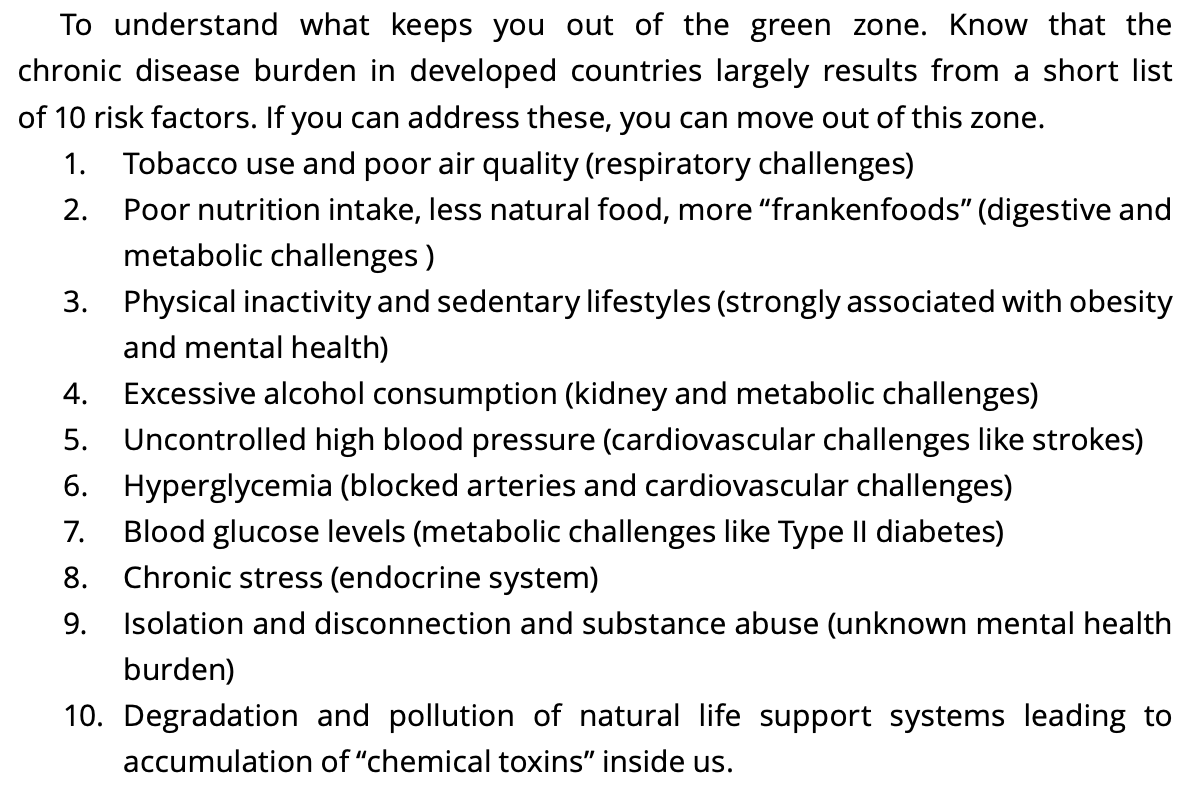
THE 4% – GREEN ZONE
(SELFCARE "GOOD HEALTH AND HARMONY")
Asking people, “How is your health?” may be a simple question, but the answers seem to be a good predictor of people’s future health care use. According to the OECD Better Life Index, about 69% of the adult population say their health is “good” or “very good.”30 They reveal that in Canada and New Zealand, 88% of adults report being in good health; while in Japan and Korea less than 40% of people rate their health as “good” or “very good.”31
According to a major new analysis from the Global Burden of Disease Study (GBD) 2013, published in The Lancet.
- Just 1 in 20 people worldwide (4·3%) had no health problems in 2013.
- A third of the world’s population (2·3 billion individuals) experience more than five ailments, which means that over 95% of the world’s population has one or more health challenges.
So where is the disconnect? Have we accepted “good health” as a state of living with one or more ailments? Especially when the research shows the proportion of lost years of healthy life (disability-adjusted life years; DALYS) are due to these ailments and illnesses, and death from these ailments rose by 21 percent.
That’s 3 in every 10 people accepting that it is normal to have both their length and quality of life restricted.
THE 1% – BLUE ZONE
(WECARE "LIVING TO LONGEVITY")
Have you ever considered living beyond your 80th birthday? Or even celebrating 100 revolutions around the sun? Well, it is available to more people than you would think. Life expectancies have been on a rise in the past century according to Statista.
The elusive dream of living beyond 80–100 years begins by managing your lifestyle habits and behaviours today. A thought, that seems too hard for many of us to deal with right now. Especially considering that many of us are still learning how to survive, let alone thrive, without disability, disease or dysfunction.
According to the World Bank, less than 3% of the global population lives beyond 80 years of age.
- 2.298% of women in 2019 and beyond are living beyond the age 80
- 1.419% of men in 2019 and beyond are living beyond the age of 80 35
However, the United Nations expect the number of centenarians to rise to approximately 573,000 worldwide. With a global population of 7,794,798,739 in 2021. Which is just 0.0073% of the global population reaching their 100th birthday! You may find this contradictory considering their increasing burden of disease. But, according to World Atlas, the U.S. has the highest number of centenarians in the world, with 97,000 living in the country. Followed closely by Japan (79,000) and China (48,921).
SUMMARY
Help us move 1 billion people from the red and orange zone to the green zone. How? Go first, impact your front doorstep and inspire your local community. If we All did just that, it would create ripple effects of intergenerational change, starting in this one, for the next.
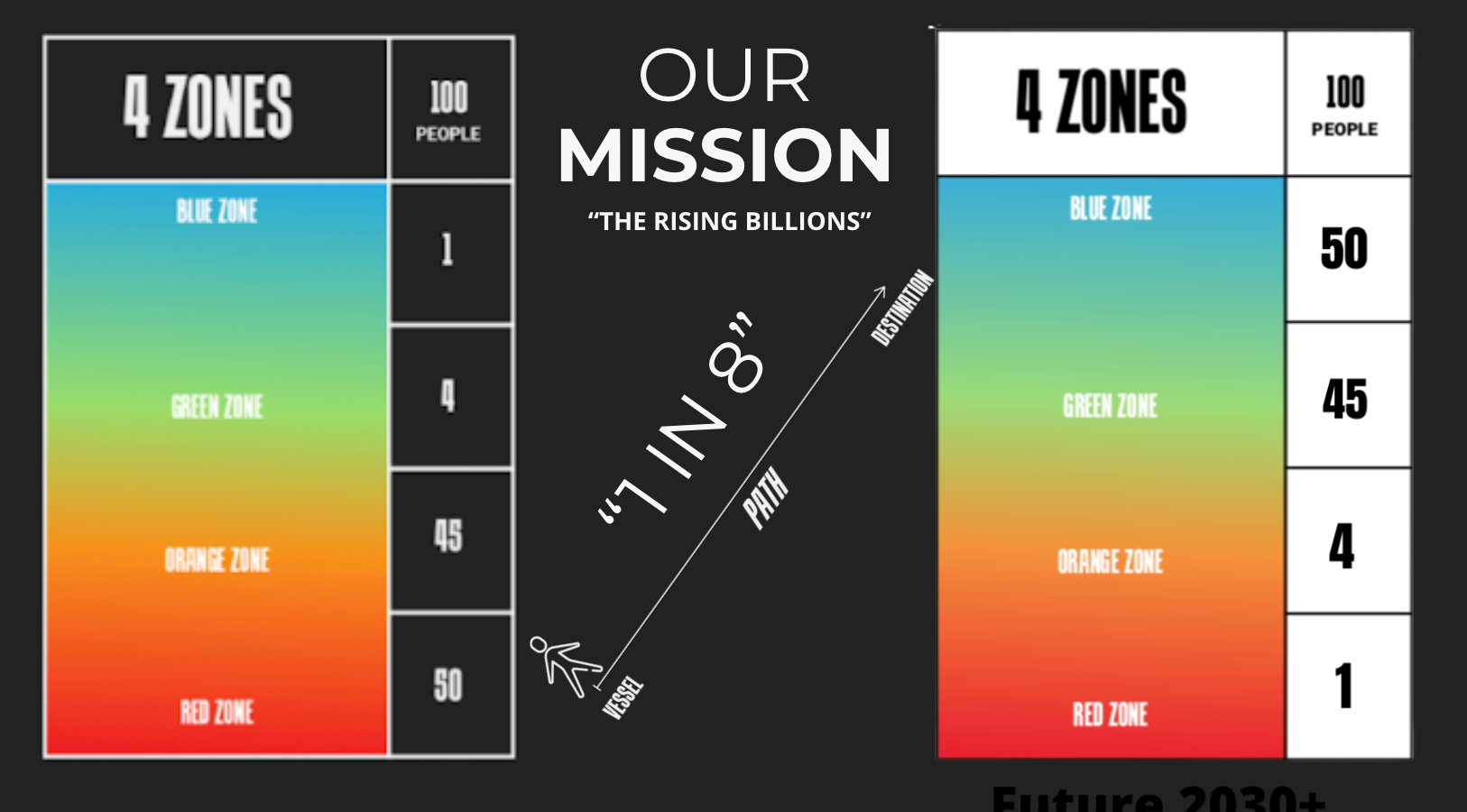
WHAT MEASURING STICK MATTERS?
Is it the quality of the life lived, even if short, but full of experience? Is it the length of a life lived, even if it was short on experiences outside our comfort zone? Is it based on who had a bigger impact? Or is it based on whose names still live on today? Or it is just based on the opportunity to live and find happiness?
Perhaps dying with no regrets is a measuring stick we can all relate to?
Perhaps the unique nature of living our own life, embracing all our choices in their imperfect perfection is what we most need to own and love. As long as it doesn’t negatively influence the people or world around us.
Perhaps Bob Marley sums it up best when he said
“Who are you to judge the life I live? I know I’m not perfect—and I don’t live to be—but before you start pointing fingers...make sure your hands are clean!”
Set your own standards and live by them, without comparison.
Call To Action
Which zone are you living in today?____________
Which zone are you moving to next?___________
What are 3 health ailments, challenges, restrictions or lifestyle-related diseases that you would like to solve or at least manage? (lower blood pressure, improve cholesterol, low back or neck pain, type II diabetes etc.)
- ________________
- ________________
- ________________
TAKE THE QUIZ BELOW TO FIND OUT
JOIN THE EMPOWER COURSE
